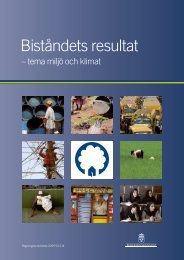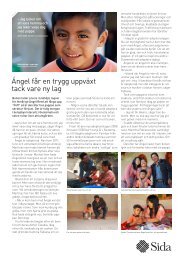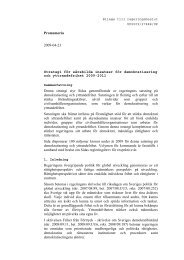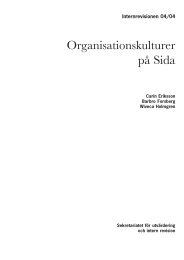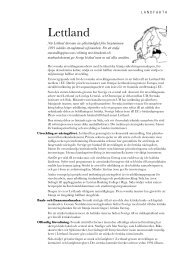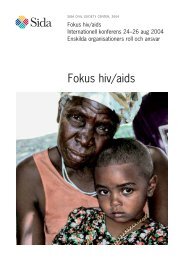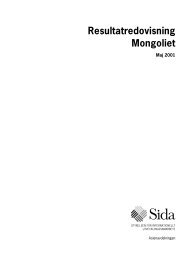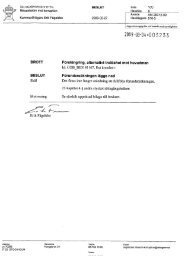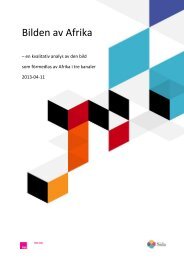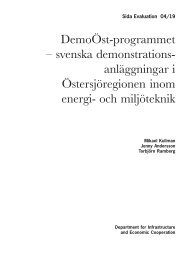Mid-Term Review of the AGIR Programme - Sida
Mid-Term Review of the AGIR Programme - Sida
Mid-Term Review of the AGIR Programme - Sida
Create successful ePaper yourself
Turn your PDF publications into a flip-book with our unique Google optimized e-Paper software.
1 I N T R O D U C T I O N<br />
Donor Intermediary CSO<br />
Understanding how <strong>AGIR</strong> intermediary<br />
organisations have influenced <strong>the</strong>ir CSO<br />
partners requires an equal understanding<br />
<strong>of</strong> <strong>the</strong> cascading levels <strong>of</strong> actors and <strong>the</strong><br />
spheres <strong>of</strong> influence that each represent.<br />
Documenting <strong>the</strong> ‘linkages’ between<br />
<strong>the</strong>se spheres <strong>of</strong> influence – essentially<br />
<strong>the</strong> ‘pathways <strong>of</strong> change’ through which<br />
influence happens – are critical to identifying<br />
and documenting outcomes (both<br />
immediate and intermediate) achieved through <strong>the</strong> work <strong>of</strong> <strong>the</strong> programme.<br />
The key to understanding and documenting <strong>the</strong>se ‘pathways to change’ (and <strong>the</strong> linkages<br />
between outputs, outcomes and impact) is to focus on <strong>the</strong> relationships between<br />
<strong>the</strong> various actors involved in <strong>the</strong> programme – in <strong>the</strong> case <strong>of</strong> <strong>AGIR</strong>, <strong>the</strong> relationships<br />
<strong>of</strong> most interest are those between <strong>the</strong> intermediaries and <strong>the</strong> CSOs, and between <strong>the</strong><br />
CSOs and <strong>the</strong> broader civil society. Each are a key part <strong>of</strong> <strong>the</strong> process through which<br />
support flows outward and outcomes/results flow back. A primary goal <strong>of</strong> this evaluative<br />
work will be to identify, analyse and document <strong>the</strong>se linkages and <strong>the</strong> results that<br />
are produced.<br />
1.2 EVALUATION PROCESSES<br />
A review <strong>of</strong> all relevant documentation connected to <strong>the</strong> programme was undertaken.<br />
Documentation from <strong>the</strong> donors, intermediaries, and partner CSOs was included (a<br />
full list <strong>of</strong> <strong>the</strong>se documents can be found in Annex 3). Initial discussions were also<br />
held with <strong>Sida</strong> and individuals from <strong>the</strong> intermediary organisations involved in<br />
<strong>AGIR</strong>. Based on <strong>the</strong>se discussions and <strong>the</strong> review <strong>of</strong> documentation, a number <strong>of</strong><br />
<strong>AGIR</strong> partner CSOs were selected for field visits (see Annex 4 for list <strong>of</strong> selected<br />
<strong>AGIR</strong> CSO partners). These selected <strong>AGIR</strong> partners were cleared with each <strong>of</strong> <strong>the</strong><br />
intermediary organisations in advance <strong>of</strong> meetings with CSOs in <strong>the</strong> field. Each intermediary<br />
agreed with <strong>the</strong> selection and, in some cases, made suggestions <strong>of</strong> additional<br />
organisations that might also be visited by <strong>the</strong> review team.<br />
Interviews were carried out with individuals and/or groups <strong>of</strong> individuals representing<br />
intermediaries and CSO partner organisations. The content <strong>of</strong> <strong>the</strong>se interviews was<br />
based on a protocol <strong>of</strong> semi-structured questions directly related to <strong>the</strong> key review<br />
questions as defined in <strong>the</strong> <strong>Sida</strong>-approved inception report under “Relevance and<br />
Evaluability <strong>of</strong> Evaluation Questions”. With CSOs in <strong>the</strong> periphery areas, who<br />
were not always aware <strong>of</strong> <strong>AGIR</strong>, <strong>the</strong> interview protocol was more loosely applied as<br />
an interview guide. Direct interviews with individuals were followed up with, if necessary,<br />
fur<strong>the</strong>r phone discussions to clarify specific issues. The team also interviewed<br />
a member <strong>of</strong> parliament involved in activities <strong>of</strong> <strong>the</strong> sub-programmes coordinated by<br />
IBIS and Diakonia.<br />
26




